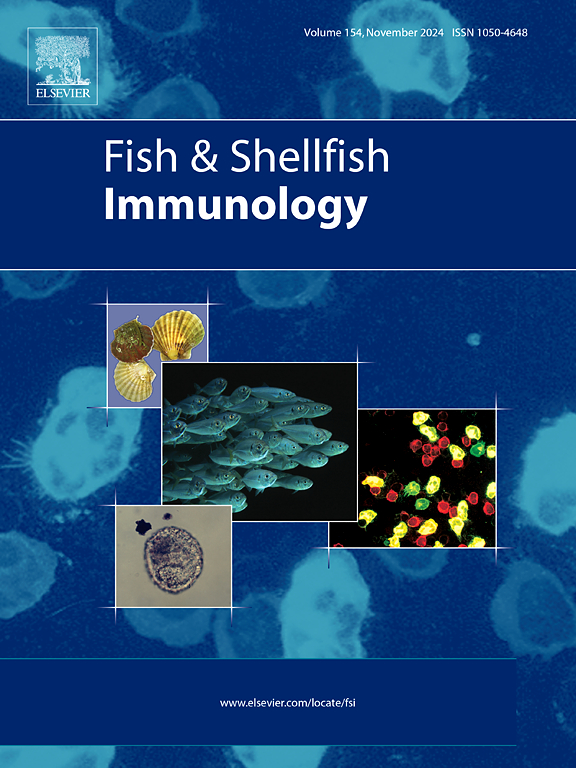斑点刀颌(Oplegnathus punctatus) TARBP2负调控I型IFN反应,促进RGNNV复制
IF 3.9
2区 农林科学
Q1 FISHERIES
引用次数: 0
摘要
反式激活反应性rna结合蛋白(Trans-Activation-Responsive RNA-Binding Protein, TARBP)是dsrna结合蛋白家族的一员,是调控基因表达和影响多种生物过程的中枢。虽然目前的研究主要集中在其细胞质与Dicer、蛋白激酶rna激活(PKR)和PKR激活因子(PACT)等因子的相互作用上,但其在硬骨鱼抗病毒免疫中的作用仍未被探索。本研究克隆并鉴定了斑点刀颌(Oplegnathus punctatus) TARBP2同源基因,命名为OpTARBP2。其开放阅读框(ORF)跨度为1038 bp,编码有345个氨基酸的蛋白,预计分子量为37.1 kDa。序列分析表明,OpTARBP2具有3个保守的dsrna结合结构域,与石斑鱼TARBP2序列同源性为96.81%。表达谱显示OpTARBP2广泛分布于组织中,在肝脏和肠道中水平最高。荧光显微镜证实其细胞质定位。在功能上,OpTARBP2在石斑鱼脾脏(GS)细胞中过表达可减少促炎细胞因子和干扰素相关基因的转录,从而促进红斑石斑鱼神经坏死病毒(RGNNV)的复制。此外,OpTARBP2显著抑制E. coioides黑色素瘤分化相关基因5 (MDA5)、线粒体抗病毒信号蛋白(MAVS)和由干扰素刺激反应元件(ISRE)和NF-κB启动子驱动的罐结合激酶1 (TBK1)诱导的荧光素酶活性。综上所述,这些结果表明,OpTARBP2通过负调控I型干扰素应答来增强病毒复制,为理解TARBP2在硬骨鱼中的抗病毒免疫作用奠定了基础。本文章由计算机程序翻译,如有差异,请以英文原文为准。
Spotted knifejaw (Oplegnathus punctatus) TARBP2 negatively regulates type I IFN responses to promote RGNNV replication
Trans-Activation-Responsive RNA-Binding Protein (TARBP), a dsRNA-binding protein family member, serves as a hub for regulating gene expression and influencing diverse biological processes. While current research primarily focuses on its cytoplasmic interactions with factors like Dicer, protein kinase RNA-activated (PKR), and PKR activator (PACT), its role in teleost antiviral immunity remains less explored. In this study, we cloned and characterized an ortholog of TARBP2 from spotted knifejaw (Oplegnathus punctatus), designated OpTARBP2. Its open reading frame (ORF) spans 1038 bp, encoding a 345-amino acid protein with a predicted molecular weight of 37.1 kDa. Sequence analysis revealed that OpTARBP2 possesses three conserved dsRNA-binding domains and shares 96.81 % sequence homology with giant grouper (Epinephelus lanceolatus) TARBP2. Expression profiling indicated widespread OpTARBP2 distribution across tissues, with highest levels in the liver and intestine. Fluorescence microscopy confirmed its cytoplasmic localization. Functionally, overexpression of OpTARBP2 in grouper spleen (GS) cells reduced the transcription of pro-inflammatory cytokines and interferon-related genes, and thereby promoting replication of the red-spotted grouper nervous necrosis virus (RGNNV). Furthermore, OpTARBP2 significantly inhibited E. coioides Melanoma differentiation-associated gene 5 (MDA5), Mitochondrial anti viral signaling protein (MAVS), and TANK-Binding Kinase 1 (TBK1)-induced luciferase activity driven by the Interferon-stimulated response elements (ISRE) and NF-κB promoters. Collectively, these results demonstrate that OpTARBP2 enhanced viral replication by negatively regulating type I interferon responses, laying a foundation for understanding the antiviral immune role of TARBP2 in teleosts.
求助全文
通过发布文献求助,成功后即可免费获取论文全文。
去求助
来源期刊

Fish & shellfish immunology
农林科学-海洋与淡水生物学
CiteScore
7.50
自引率
19.10%
发文量
750
审稿时长
68 days
期刊介绍:
Fish and Shellfish Immunology rapidly publishes high-quality, peer-refereed contributions in the expanding fields of fish and shellfish immunology. It presents studies on the basic mechanisms of both the specific and non-specific defense systems, the cells, tissues, and humoral factors involved, their dependence on environmental and intrinsic factors, response to pathogens, response to vaccination, and applied studies on the development of specific vaccines for use in the aquaculture industry.
 求助内容:
求助内容: 应助结果提醒方式:
应助结果提醒方式:


